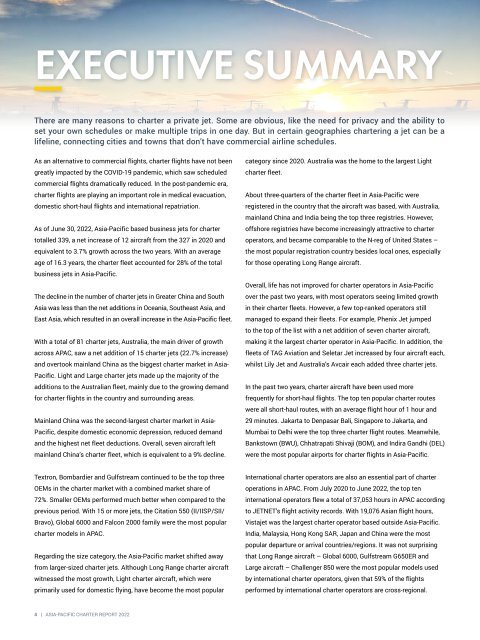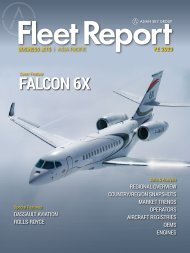You also want an ePaper? Increase the reach of your titles
YUMPU automatically turns print PDFs into web optimized ePapers that Google loves.
EXECUTIVE SUMMARY<br />
There are many reasons to charter a private jet. Some are obvious, like the need for privacy and the ability to<br />
set your own schedules or make multiple trips in one day. But in certain geographies chartering a jet can be a<br />
lifeline, connecting cities and towns that don’t have commercial airline schedules.<br />
As an alternative to commercial flights, charter flights have not been<br />
greatly impacted by the COVID-19 pandemic, which saw scheduled<br />
commercial flights dramatically reduced. In the post-pandemic era,<br />
charter flights are playing an important role in medical evacuation,<br />
domestic short-haul flights and international repatriation.<br />
As of June 30, <strong>2022</strong>, Asia-Pacific based business jets for charter<br />
totalled 339, a net increase of 12 aircraft from the 327 in 2020 and<br />
equivalent to 3.7% growth across the two years. With an average<br />
age of 16.3 years, the charter fleet accounted for 28% of the total<br />
business jets in Asia-Pacific.<br />
The decline in the number of charter jets in Greater China and South<br />
Asia was less than the net additions in Oceania, Southeast Asia, and<br />
East Asia, which resulted in an overall increase in the Asia-Pacific fleet.<br />
With a total of 81 charter jets, Australia, the main driver of growth<br />
across APAC, saw a net addition of 15 charter jets (22.7% increase)<br />
and overtook mainland China as the biggest charter market in Asia-<br />
Pacific. Light and Large charter jets made up the majority of the<br />
additions to the Australian fleet, mainly due to the growing demand<br />
for charter flights in the country and surrounding areas.<br />
Mainland China was the second-largest charter market in Asia-<br />
Pacific, despite domestic economic depression, reduced demand<br />
and the highest net fleet deductions. Overall, seven aircraft left<br />
mainland China’s charter fleet, which is equivalent to a 9% decline.<br />
category since 2020. Australia was the home to the largest Light<br />
charter fleet.<br />
About three-quarters of the charter fleet in Asia-Pacific were<br />
registered in the country that the aircraft was based, with Australia,<br />
mainland China and India being the top three registries. However,<br />
offshore registries have become increasingly attractive to charter<br />
operators, and became comparable to the N-reg of United States –<br />
the most popular registration country besides local ones, especially<br />
for those operating Long Range aircraft.<br />
Overall, life has not improved for charter operators in Asia-Pacific<br />
over the past two years, with most operators seeing limited growth<br />
in their charter fleets. However, a few top-ranked operators still<br />
managed to expand their fleets. For example, Phenix Jet jumped<br />
to the top of the list with a net addition of seven charter aircraft,<br />
making it the largest charter operator in Asia-Pacific. In addition, the<br />
fleets of TAG Aviation and Seletar Jet increased by four aircraft each,<br />
whilst Lily Jet and Australia’s Avcair each added three charter jets.<br />
In the past two years, charter aircraft have been used more<br />
frequently for short-haul flights. The top ten popular charter routes<br />
were all short-haul routes, with an average flight hour of 1 hour and<br />
29 minutes. Jakarta to Denpasar Bali, Singapore to Jakarta, and<br />
Mumbai to Delhi were the top three charter flight routes. Meanwhile,<br />
Bankstown (BWU), Chhatrapati Shivaji (BOM), and Indira Gandhi (DEL)<br />
were the most popular airports for charter flights in Asia-Pacific.<br />
Textron, Bombardier and Gulfstream continued to be the top three<br />
OEMs in the charter market with a combined market share of<br />
72%. Smaller OEMs performed much better when compared to the<br />
previous period. With 15 or more jets, the Citation 550 (II/IISP/SII/<br />
Bravo), Global 6000 and Falcon 2000 family were the most popular<br />
charter models in APAC.<br />
Regarding the size category, the Asia-Pacific market shifted away<br />
from larger-sized charter jets. Although Long Range charter aircraft<br />
witnessed the most growth, Light charter aircraft, which were<br />
primarily used for domestic flying, have become the most popular<br />
International charter operators are also an essential part of charter<br />
operations in APAC. From July 2020 to June <strong>2022</strong>, the top ten<br />
international operators flew a total of 37,053 hours in APAC according<br />
to JETNET’s flight activity records. With 19,076 Asian flight hours,<br />
Vistajet was the largest charter operator based outside Asia-Pacific.<br />
India, Malaysia, Hong Kong SAR, Japan and China were the most<br />
popular departure or arrival countries/regions. It was not surprising<br />
that Long Range aircraft – Global 6000, Gulfstream G650ER and<br />
Large aircraft – Challenger 850 were the most popular models used<br />
by international charter operators, given that 59% of the flights<br />
performed by international charter operators are cross-regional.<br />
4 | ASIA-PACIFIC CHARTER REPORT <strong>2022</strong>

















